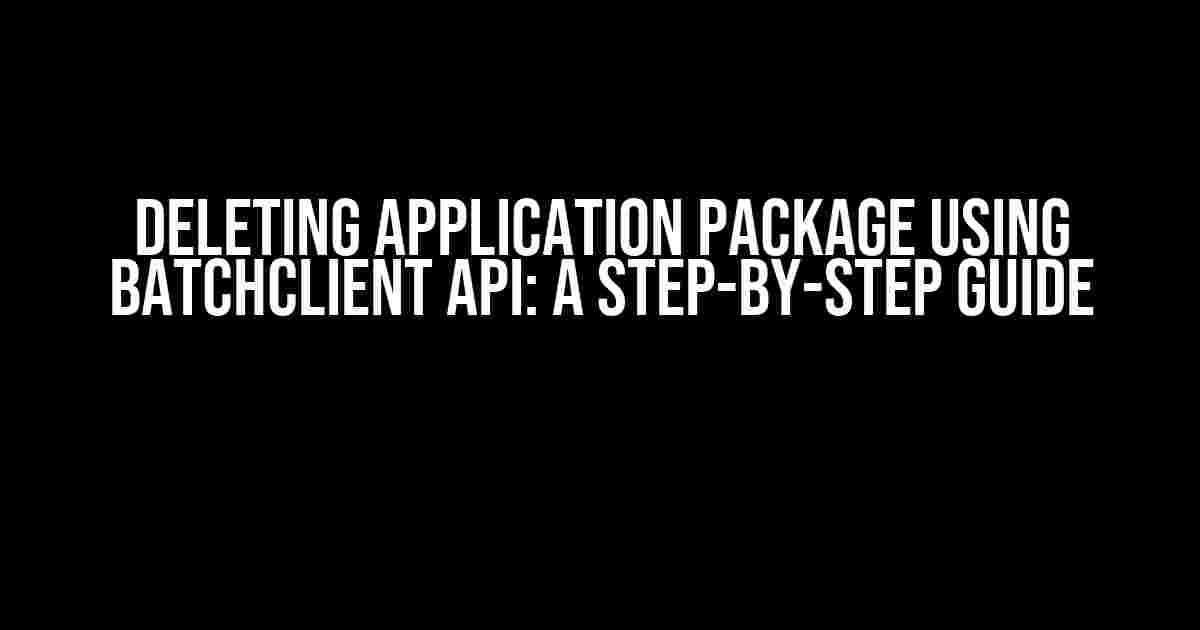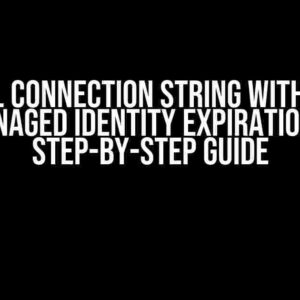Are you struggling to delete application packages using the BatchClient API? Do you find yourself stuck in a loop of trial and error, trying to figure out the correct syntax and parameters? Fear not, dear developer, for this article is here to guide you through the process with ease and precision.
What is the BatchClient API?
The BatchClient API is a powerful tool provided by Azure Batch, allowing developers to create, manage, and interact with batch computing resources. With the API, you can programmatically submit jobs, monitor tasks, and even delete application packages. But, before we dive into the deletion process, let’s quickly cover the basics.
What is an Application Package?
An application package is a container that holds the binaries and dependencies required to run a specific application on Azure Batch. Think of it as a package manager for your batch computing needs. When you create an application package, you can specify the files, environment variables, and configurations required to run your application. However, sometimes, you may need to delete an application package, and that’s where this article comes in.
Why Delete an Application Package?
There are several reasons why you might want to delete an application package:
-
You’ve created a new version of your application and want to retire the old one.
-
You’ve made changes to your application’s dependencies and want to update the package.
-
You’ve discovered an issue with the package and want to recreate it from scratch.
-
You’re simply cleaning up your Azure Batch resources and want to remove unused packages.
Deleting an Application Package using BatchClient API
Now, let’s get down to business! To delete an application package using the BatchClient API, you’ll need to follow these steps:
-
Install the Azure Batch SDK: Make sure you have the Azure Batch SDK installed on your machine. You can do this by running the following command in your terminal or command prompt:
pip install azure-batch -
Import the necessary modules: In your Python script, import the necessary modules:
from azure.batch import BatchServiceClient from azure.batch import BatchServiceClientConfiguration -
Create a BatchClient instance: Create a BatchClient instance, passing in your Azure Batch account credentials:
batch_client = BatchServiceClient( BatchServiceClientConfiguration( account_name='your_account_name', account_key='your_account_key', batch_url='https://your_batch_account_url' ) ) -
Get the application package ID: Retrieve the ID of the application package you want to delete:
app_package_id = 'your_app_package_id' -
Delete the application package: Use the `delete_application_package` method to delete the application package:
batch_client.application_packages.delete(app_package_id)
That’s it! With these steps, you should be able to successfully delete an application package using the BatchClient API. But, if you’re not careful, you might encounter some common errors.
Here are some common errors you might encounter when deleting an application package using the BatchClient API:
| Error | Solution |
|---|---|
azure.batch.models.BatchErrorException: (404) ApplicationPackageNotFound |
Ensure the application package ID is correct and exists in your Azure Batch account. |
azure.batch.models.BatchErrorException: (403) AuthorizationFailed |
Verify your Azure Batch account credentials and ensure you have the necessary permissions to delete application packages. |
azure.batch.models.BatchErrorException: (500) InternalServerError |
Check the Azure Batch service status and try deleting the application package again. If the issue persists, contact Azure support. |
Conclusion
Deleting an application package using the BatchClient API is a straightforward process, but it requires attention to detail and a understanding of the Azure Batch ecosystem. By following the steps outlined in this article, you should be able to successfully delete application packages and maintain a clean and organized Azure Batch environment. Remember to handle errors gracefully and troubleshoot any issues that may arise.
With this guide, you’re one step closer to becoming an Azure Batch expert! If you have any questions or need further assistance, don’t hesitate to reach out. Happy coding!
Frequently Asked Question
Deleting an application package using the BatchClient API can be a bit tricky, but don’t worry, we’ve got you covered!
Q: What is the BatchClient API and how does it relate to deleting application packages?
The BatchClient API is a .NET library that allows you to interact with Azure Batch services, including deleting application packages. You can use the API to programmatically delete application packages, making it easier to manage your Batch workflows.
Q: What are the requirements for deleting an application package using the BatchClient API?
To delete an application package using the BatchClient API, you’ll need to have the Azure Batch NuGet package installed in your project, as well as the necessary credentials to authenticate with your Azure Batch account. You’ll also need to ensure that you have the correct permissions to delete application packages.
Q: How do I delete an application package using the BatchClient API?
To delete an application package, you can use the `DeleteApplicationPackageAsync` method provided by the BatchClient API. This method takes the application package ID and version as parameters, and deletes the specified package. You can also use the `DeleteApplicationPackage` method, which is a synchronous version of the asynchronous method.
Q: What happens if I try to delete an application package that is still in use by a job or task?
If you try to delete an application package that is still in use by a job or task, the deletion operation will fail and an error will be thrown. This is because Azure Batch ensures that application packages are not deleted while they are still being used by running jobs or tasks.
Q: Are there any best practices for deleting application packages using the BatchClient API?
Yes, it’s a good idea to implement error handling and logging when deleting application packages using the BatchClient API. You should also ensure that you have the correct permissions and credentials to delete application packages, and that you’re using the correct package ID and version. Additionally, consider implementing a retry mechanism in case of transient errors.



